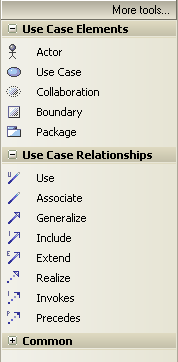Use Case elements are used to build Use Case models. These describe the functionality of the system to be built, the requirements, the constraints and how the user interacts with the system. Often Sequence diagrams are associated with Use Cases to capture work flow and system behavior.
|
The Use Case group is used to model the system functionality from the perspective of a system user. The user is called an Actor and is drawn as a stick figure, although the user could be another computer system or similar. A Use Case is a discrete piece of functionality the system provides that enables the user to perform some piece of work or something of value using the system. Examples of Use Cases are: login, open account, transfer funds, check balance and logout; each of these implies some purposeful and discrete functionality the system is to provide to a user. The connectors available include: associate (an actor uses a Use Case), extend (one Use Case can extend another), include (one Use Case can include another) and realize (this Use Case might realize some business requirement). To add an element to the current diagram, click on the required icon and drag it into position on the diagram. Set an element name and other properties as prompted. To add a relationship, click on the required icon, then click on the start element in the diagram and drag to the end element. Note: Invokes and Precedes relationships are defined by the Open Modeling Language (OML). |



